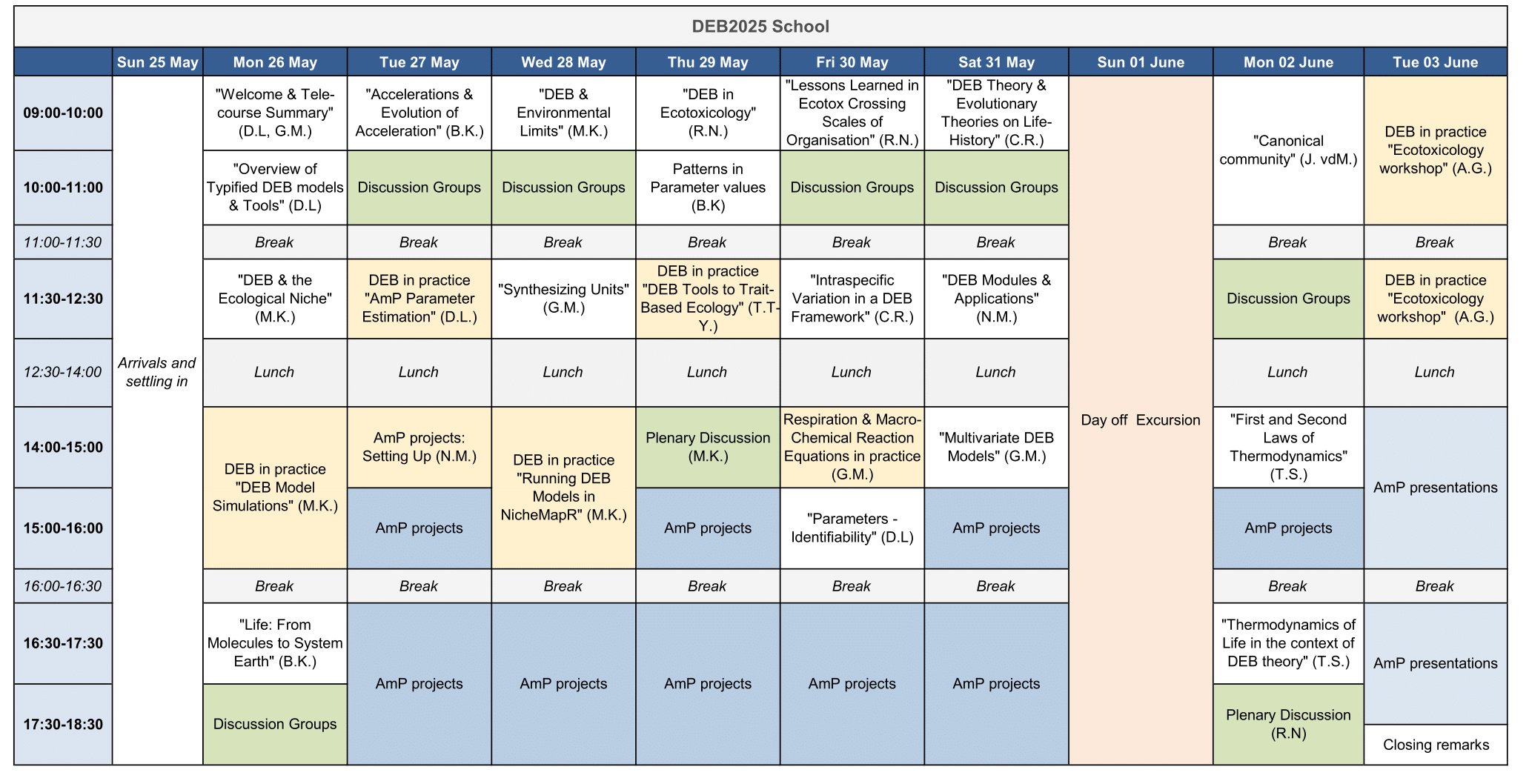
|
|
|
School > Planning and content
School program
The DEB2025 practical course program is comprised of a balanced mix of lectures, 'DEB in practice' hands-on exercises, small group discussions (followed by pleanry discussions), and personal AmP projects.
During the first six days (Mon 26 to Sat 31), time will be divided between lectures, discussion groups (in green in the program below), DEB in practice excercices (in yellow), and AmP projects (in blue), during which participants will have time to dedicate to their own project for developing their DEB applications (called AmP project in reference to the parameter estimation technique Add-my-Pet). Discussion groups will be constituted of ~7 students and 1-2 teachers to talk about a predefined theme related to DEB modelling and also exchange on each participants' own project and goals. After three sessions, a plenary discussion will be held to share to the wider group.
On Sunday 01 we will take a break for a well deserved excursion (sight-seeing, hiking, relaxing).
The last two days of the course will contain a mix of workshops (DEB in practice), some lectures, and the conclusion of a second round of discussions (different composition from the first one). On the last day of the course, each student will have the opportunity to present either alone or in a small group their results and receive feedback on their progress, questions, and issues.
Course program:
Download the schedule PDF here.
The Course document
We will refer to a course document compiling information on the agenda, the content of lectures, material for DEB in practice, information on teachers and participants, etc. The course document is regularily updated, so always refer the latest version.
Download the course document PDF here.
Teaching team
- A.G. : André Gergs (Bayer AG, Monheim, Germany)
- M.K. : Michael Kearney (University of Melbourne, Melbourne, Australia)
- B.K. : Bas Kooijman (VU Universiteit Amsterdam, Amsterdam, Netherlands)
- R.L. : Romain Lavaud (Louisiana State University Agricultural Center, Baton Rouge, LA, United States)
- D.L. : Dina Lika (University of Crete, Heraklion, Greece)
- G.M. : Gonçalo Marques (University of Lisbon, Lisbon, Portugal)
- N.M. : Nina Marn (Ruđer Bošković Institute, Zagreb, Croatia)
- R.N. : Roger Nisbet (University of California, Santa Barbara, CA, United States)
- C.R. : Charlotte Récapet (Université de Pau et des Pays de l'Adour, France)
- T.S. : Tânia Sousa (University of Lisbon, Lisbon, Portugal)
- T.T-Y. : Tan Tjui-Yeuw (Wageningen University Research, Wageningen, The Netherlands)
- J.vdM. : Jaap van der Meer (Wageningen University Research, Wageningen, The Netherlands)
Teaching assistants
- Urban Dajčman (National Institute of Biology, Ljubljana, Slovenia)
- Evridiki Klagkou (University of Crete, Heraklion, Greece)
- Maria Lagunes (MARBEC, IRD, Univ Montpellier, CNRS, Ifremer, Sète, France)
- Diogo F. Oliveira (MARETEC/LARSyS, IST, Universidade de Lisboa, Lisbon, Portugal)
- Orestis Stavrakidis-Zachou (Hellenic Centre for Marine Research, Heraklion, Greece)

